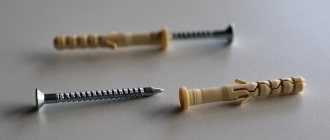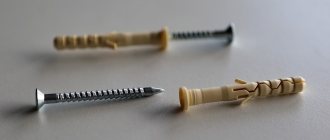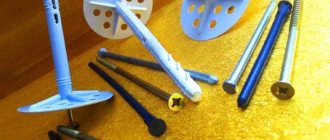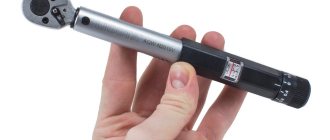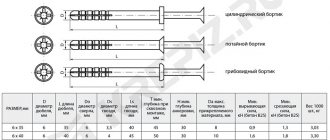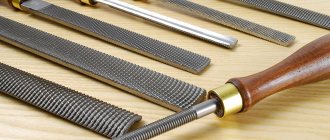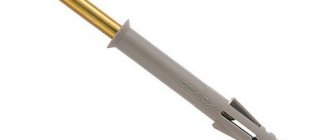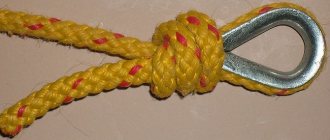The modern dowel-nail replaced wooden dowels, which often split into pieces, dried out and did not adhere well to the load-bearing surface. Composite fasteners with a spacer sleeve significantly speed up most installation work, providing the most reliable fastening of furniture and other products.
What is a dowel-nail?
There is a huge range of fasteners. You need to know what a dowel-nail looks like and understand its varieties in order to choose the best installation method for the job. In the most common version, it is a composite product of two items - a nail and a dowel. When driving the rod, the spacer part expands and is fixed in the surface. The dowel and nail can be made of different materials; more often, depending on the conditions, durable steel or plastic is used.
Dowel fastener. Types of products
These products are divided into categories according to:
fastening method
The design features, as well as the base material, are taken into account. If the base is of high density, which causes certain difficulties in the process of fastening various elements, you should use dowels for brick or concrete
To work with such surfaces, you can choose: Expansion dowel. Depending on the manufacturer, the product may differ in shape, as well as in the number of teeth, ailerons, and spikes. Universal fastener. In solid materials it manifests itself in the same way as the spacer type, but in hollow materials it shows different qualities. Facade dowel and frame. The products are designed for fastening into dense bases, even if they are classified as slotted. Nail type. Designed for mass quick installation. Most often requires the use of a mounting gun. If the work will be carried out with loose or hollow materials, then in these cases it is better to choose a universal option, frame (can be used when installed in a foam concrete base during the installation of plastic door and window structures), driven (for aerated concrete), as well as screw-on, panel and sheet dowel.
type of installation
In this case, it is not the method of immersing nails into dowels that is taken into account, but the installation of the dowel itself. Today there are two methods: Pre-installation
The fasteners are fixed into the base. The attached element fits as tightly as possible to the “body”. The largest percentage of types of dowels work exactly according to the mentioned principle (universal, nail, spacer). Through installation. Before fastening into the base, the fastener must pass through a void area or a certain layer of intermediate material. To carry out this process, a product with an elongated non-expanding part is used. We are talking about frame, facade, and roofing dowels. In addition, there are models of fasteners for insulation. They can be either spacer or non-spacer. They are distinguished by the presence of a rather large cap (diameter - from 45 to 90 mm), which allows them to hold loose material, as well as soft ones.
- material. Most often, dowel fasteners are made using plastic. This is explained by the fact that the level of installation strength is determined by the ease, as well as the force of deformation. Plastic is endowed with elasticity and viscosity, which allows it to deform more easily than other materials. At the same time, the plastic does not lose its characteristics. Thus, today there are dowels made from the following materials:
- Polyethylene. The products are lightweight and resistant to acids. The raw material is endowed with excellent viscosity and is able to retain its qualities during deformation. Fastening material made of polyethylene is resistant to corrosion reactions and is not subject to cracking after long-term use. It is resistant to low temperatures (used at –40 degrees Celsius).
- Polypropylene. It has high hardness and wear resistance, but cannot be used at very low temperatures. But it performs well at high temperatures (deformation is observed at +140 °C or more).
- Nylon or polyamide. Products made from this material are endowed with a high level of rigidity and strength. They are resistant to mechanical stress and vibration processes, and are durable. A nylon dowel is recognized as a more reliable fastener, but it is not recommended to use it in frosty or humid weather.
Why do you need a dowel-nail?
The main purpose of this product is to securely attach to the load-bearing surface. A dowel-nail for concrete or brick allows you to significantly speed up the pace of work. The presence of a limiting cuff helps not to bury the cap too much into the surface. Nowadays, to fix the slats, it is not necessary to make precise markings. The holes are drilled directly into the plank and the prepared dowel-nails are driven directly through them. The slots on the caps are made to simplify the dismantling of products.
Dowel-nail - characteristics
When preparing for construction work, you need to purchase a lot of consumables. Depending on the type and size, the mounting dowel-nail has different technical characteristics. Let's consider the main parameters of this fastener (minimum and maximum data) using the example of polypropylene products with a hidden side:
- The designation of dowel-nails
is from 6x40 to 10x100. - Do
- hole for dowel (from 6 to 10 mm). - L
– dowel length (from 40 to 100 mm). - Ds
– diameter of nails (from 4 to 7 mm). - Ls
– length of nails (from 42 to 102 mm). - T
– depth of the hole for the dowel-nail for through installation (from 50 to 150 mm). - H
– anchorage depth (from 30 to 50 mm). - Da
– thickness of the attached product (from 10 to 100 mm). - The magnitude of the pulling force (for B25 concrete)
is from 1.6 to 2.4 kN. - The magnitude of the shear force (for B25 concrete)
is from 1.8 to 4.1 kN. - Weight 100 pcs.
dowel-nails - from 3.3 to 15.32 kg.
What is better, a dowel-nail or a dowel-screw?
In both cases, we have products consisting of two elements - a spacer part and a rod (nail, screw). The main difference between a dowel-nail and a dowel-screw is the method of installation in a load-bearing surface. In the first case, you need to drive a nail, and in the version with a screw, the fasteners are screwed in with an electric tool or a screwdriver. Let's consider the advantages and disadvantages of each option.
Dowel nail:
- Installation is faster.
- Suitable for installation in any solid wall except drywall.
- Due to impact loads, the risk of destruction of the front surface increases.
Dowel screw:
- Installation takes longer.
- Dismantling is easy.
- The fastening is considered more reliable.
- Less risk of damage to the façade.
What is better, a dowel-nail or a self-tapping screw?
It is wrong to compare both types of fasteners; they are designed to work in different conditions. A dowel-nail is excellent for brick, concrete, and dense foam block. Screws are recommended for plastic, chipboard or wood. In a pliable material, when screwed in, internal threads are formed that keep the product from being pulled out. If you have to work with metal, durable types of plastic or wood, it is better to use self-tapping screws with a sharp tip or drill.
How to choose the right dowel
Dowels for self-tapping screws are selected based on the location of their attachment and the weight of the structure. It is important that the fastener fits tightly into the hole, so it must match its outer diameter. The product is selected based on the base material, which will ensure reliable and durable fixation. To perform installation work indoors, you can choose any product. For fastening external structures, it is better to give preference to elements made of polyamide, which are resistant to temperature fluctuations and low temperatures.
For outdoor work it is better to choose a metal dowel
An important point is the type of surface. To deepen the dowel into a solid base, spacers are used. For hollow, layered or multi-hollow walls, anchor dowels are used.
Important! There are special purpose dowels designed for a specific type of surface, such as plasterboard, concrete, sheet substrates or facades.
The depth and type of dowel depend on the load that the fastening will support. The larger it is, the more powerful and longer the product should be.
For heavy massive products in the form of wall bars or wall-mounted exercise machines, fasteners with a depth of at least 85 mm should be used. When thinking about how to fix a shelf on the wall, you should take care of purchasing dowels with an outer diameter of 7-11 mm and a depth of at least 30 mm, which will ensure the strength and reliability of fastening the structure. In the case of installing ceiling lamps, fixing a suspended ceiling and other products in which the main load is located from below, dowels with spacer antennae or transverse notches are selected.
The use of polymer dowels for aerated concrete walls
Types of dowel-nails
Depending on the conditions, builders have to use different tools. For example, attaching an object to a concrete or plasterboard wall has a significant difference. In some cases, the reinforced strength of the rod is important, in other places - thermal conductivity and moisture resistance. Even a seemingly simple driven dowel-nail has several varieties, which differ not only in size and material, but also in the method of installation.
Common types of dowel nails:
- Dowel-nail for manual installation
. - Dowel-nail for a gun
- installation is carried out using an automatic device, which greatly speeds up the progress of work. It does not have a spacer part. The nail is made of the strongest steel (hardness 53-56 HRC, bending no more than 0.1 mm). - Acoustic dowel-nail
- in the manufacture of fasteners, not metal is used, but plastic and fiberglass, which prevents corrosion or the passage of cold. Consumables of this type are used for installation of thermal insulation, sound insulation, cable ducts, and decoration. - Dowel-nail “umbrella”
– has a wide head and a long body, used for fixing thermal insulation.
Plastic dowel nails
A cup made of synthetic material has a spacer and non-spacer surface. The plastic dowel-nail is equipped with a cuff that prevents the fastener from falling into the surface. The presence of toothed elements prevents the product from scrolling in the hole. We list the common types of plastic fasteners:
- Universal dowel
- used together with wood and chipboard screws, screw-screws, suitable for hollow and solid materials. - Expansion dowel S
- nylon fasteners have a double-sided expansion. The absence of a stop edge allows you to hide the dowel inside the plaster. - MS Expansion Dowel
– Suitable for use with standard bolts or threaded rods. - Dowels for aerated concrete GB
– the presence of spiral ribs allows for a very strong fit in soft materials. - Dowels for mounting TV/TVV steps
– have a good surface geometry to prevent creaking and vibration. TV brand fasteners have a small spacer for installation in a steel profile.
Metal dowel nails
The use of a steel spacer sleeve increases the cost of the estimate, but allows you to increase the design load. A metal dowel-nail for foam blocks, brick structures or concrete structures is installed in the same way as plastic fasteners. We list the advantages and disadvantages of this product:
- High load-bearing capacity.
- Metal does not stretch over time.
- The galvanized or stainless steel sleeve is resistant to corrosion.
- Large selection of fasteners.
- Easy installation.
- The cost of dowel-nails made of metal is higher.
- It must be taken into account that steel fasteners can create more stress, so it is better to place them further from the edge.
The design of the butterfly dowel and its installation
Butterfly dowel
A butterfly dowel is a fastening device that resembles a butterfly in shape. During the process of twisting, the dowel is compressed, due to which special legs are pressed against the back wall of the drywall. One of the advantages of this fastener is that it increases the area of pressure generated when hanging an object. In other words, the specific shape of the butterfly dowel evenly distributes the entire resulting load on the drywall. Several design features should be highlighted:
- Used for installing single and double sheets of drywall, respectively. The butterfly dowel can also be used for fastening chipboard, gypsum fiber board and other sheet building materials that are suitable in thickness.
- Sold complete with a self-tapping screw according to the length and type of thread. However, if for some reason it does not fit, you can replace it with another type of screw.
- The part of the dowel that is inside the drywall sheet does not rotate around its axis. This is achieved thanks to the ribbed surface of the element.
- Internal threads on the far head facilitate clamping and folding. And the presence of special internal legs, which are attached to this head, provide greater rigidity when the butterfly dowel is twisted.
Installation of a butterfly dowel
Fastening this dowel is quite simple and reliable. A few minutes are enough for this. The installation sequence is as follows:
- Where it is planned to organize the fastening, a mark is made with a pencil.
- A drill makes a hole. It should be of such depth that the plastic dowel fits completely.
- Then fasteners are put on the self-tapping screw. It could be just a bracket, a hook, a special plate, a clamp, and so on.
- At the last stage, a self-tapping screw is screwed into the dowel until it stops. During the screwing process, the plastic dowel behind the sheet of drywall folds. This can be felt during the process of twisting it. To check the strength, lightly pull the dowel towards you. But be careful not to tear it out.
In some cases, it can be problematic to use a butterfly dowel. This is due to the fact that the space between the drywall and the wall is very small. In this case, you need to drill a small hole in the wall. This will allow you to screw the self-tapping screw into the plastic dowel without any problems. This method will avoid using a long dowel and screw to secure it to the wall. Thus, the suspended structure will rest securely on the drywall.
How to choose a dowel-nail?
When purchasing consumables, you should take into account their design features. For example, a dowel-nail for insulation has an elongated body to pierce through a block of mineral wool or foam plastic, and a wide head to hold soft material. The shape of the plastic head must meet the mounting conditions. Cone-shaped “sunk” caps are recommended for window frames or wooden beams. When fixing metal brackets, a tighter fit of the cap to the plane is required. Taking into account the type of supporting base, the spacer part of the fastener is selected:
- For a solid base, where anchoring occurs due to friction, a universal dowel-nail is suitable.
- In porous blocks, anchoring is carried out due to the special shape of the sleeve. For example, dowel-nails for aerated concrete have a spiral spacer part.
Dowel-nail - dimensions
Understanding the standard sizes of this fastener is very simple. When choosing a dowel-nail for drywall, foam blocks or brick, you need to know exactly the thickness of the material being attached and the design load. The first number on the marking indicates the outer diameter of the spacer, and the second number indicates its length. For fasteners with polypropylene spacers, the following standard sizes are available:
- 6x40;
- 6x60;
- 6x80;
- 8x60;
- 8x80;
- 8x100;
- 8x120;
- 8x140;
- 10x100.
Dowel nails for an automatic gun have a smaller selection of standard sizes:
- 4.5x30;
- 4.5x40;
- 4.5x50;
- 4.5x60;
- 4.5x80;
- 5x100.
Useful tips
How to hammer a dowel? The diameter of the fastener must be selected so that it fits into the drilled hole with some force. If the diameter of the fastener significantly exceeds the size of the hole, the dowel will deform during installation. A dowel that is too small will fall out or hang loose in the hole.
If you need to install a dowel in a loose foundation, then additional reinforcement of the connection will be required. To increase the friction force, it is necessary to wrap electrical tape or a plaster bandage around the fastening element, which must first be moistened in water. If you need to hang a heavy object, the dowel hole can be filled with a special adhesive (liquid nails). After this, you need to hammer in the fastening element and screw in the self-tapping screw.
How to attach a dowel-nail?
Having understood the standard sizes and learned to use an impact drill and hammer drill, it is very easy to install structures using this fastener. The instructions on how to use a dowel-nail are simple:
- Mark the center of the hole.
- We use a puncher to punch a hole of the required diameter, taking into account the markings.
- The length of the hole should be 5-6 mm longer than the dowel used.
- It is advisable to clean the hole from dust with a vacuum cleaner.
- Carefully hammer in the dowel spacer cartridge with a hammer.
- We hammer in a nail, if necessary leaving 2-3 mm for attaching the suspension.
- When fixing brackets or strips, the dowel is inserted from above through the mounting hole in the product.
How to drive a dowel nail into drywall, ceramic or tiles
When installing drywall, you should take into account in advance the weight of the load that is attached to it. In cases where the weight of the load is quite high, it is impossible to use a dowel fastener, since it will simply destroy a fairly light plasterboard surface. In other situations (light load weight), driving a dowel-nail is a very simple procedure:
- a hole of the required cross-section is made in the drywall;
- the fastener is inserted all the way into the hole (in this case, you should not hit the fastening element with a hammer with all your strength, but only lightly tap);
- The screw is tightened manually or using a screwdriver.
When working with tiles made of tiles or ceramics, installation of fasteners is also simple, but the work should be done with extreme caution, given its high fragility. The fastening diagram is as follows:
- a marker marks the point of entry of the fastener into the tile (this can be either a seam or the surface of the material);
- Lightly tapping a metal screw using a self-tapping screw makes a hole on the surface of the enamel (up to 0.5 millimeters), and only after that use an impact drill, which drills through the tile (ceramics) to its entire thickness.
Do not forget that you will also need to make a hole under the tile in accordance with the instructions for brick or concrete (they are outlined above), and then install the fastening device into the tile and brick or concrete surface.
How to remove a dowel-nail?
Often, during dismantling, the plastic part becomes firmly stuck in the surface. To pull out a dowel-nail for concrete or other material, craftsmen have invented several tricks:
- We screw the screw into the spacer cup and then use pliers to pull the product out of the wall.
- In serious cases, it is better to use a nail puller instead of pliers.
- If the tip of the screw is broken, you can melt the plastic part enough so that the exposed surface is enough to grip the pliers.
- The metal dowel-nail will first have to be loosened a little in order to be pulled out of the wall.
- If the metal part protrudes very little, then you need to use a hammer drill to make a recess around the head in order to reduce adhesion to the material and free up part of the dowel for a comfortable grip.
Varieties
Conventionally, fasteners for sheet materials can be divided into 2 groups. They increase the density of the walls in the hole by exerting a bursting effect on the plaster. Others compress the canvas from both sides, interacting simultaneously with the core and the reinforcing shell. Let's look at what types of drywall dowels exist in each subgroup.
Driva
The spacer version of the dowel is made of metal or plastic (nylon, polyethylene, polypropylene). In design, it is a cone-shaped element with a wide thread and a pointed tip. The cap has a relatively large diameter. Inside there is a cross-shaped groove for screwing in the product using a screwdriver or PH2 bit.
The tip is used to form a hole (trident or feather). However, it is worth noting that low-quality plastic does not cope well with its task due to its softness. Sometimes melting due to torque is observed. You can correct the situation using any self-tapping screw - you need to form a small recess by cutting through the cardboard. Another option is a drill with a diameter of 6 or 8 mm.
Metal drive Source kabelprovod161.ru
Characteristics:
- sizes of plastic samples: 15*23 or 12*32 mm;
- metal products have other parameters: 14*28 or 15*38 mm;
- the permissible load for the former is limited to 25 kg, for the latter up to 32 kg;
- operating conditions: -40-+50 degrees Celsius;
- Recycling is acceptable.
The use of such dowels is relevant in conditions of small and large distances between the rough base and the gypsum board. Installation is carried out in 2 steps. First, the Driva is immersed in the canvas by screwing. Then a self-tapping screw or screw is screwed in. It is important to avoid over-tightening, as this will cause the dowel to rotate. Such fixation is considered unreliable.
See also: Catalog of companies that specialize in finishing materials and related work
Butterfly
The crimp type of dowel is made of metal or plastic. Here the rod is divided into 2 parts: submersible (with a corrugated surface for reliable fixation of the position) into the drywall and a seat for the self-tapping screw. The elements are connected to each other by two petals, which “unfold” as the screw is screwed in. Also inside there may be stops attached to the free rod part. They serve to adjust the bend of the “wings” of the drywall butterfly.
Plastic butterfly Source berezka-stroi.ru
Characteristics:
- material – polypropylene or nylon, galvanized steel (rarely found and more expensive;
- the immersed part of the rod is designed to work with canvases with a thickness of 10-12 mm;
- case length – 12-260 mm, diameter – 4, 8 or 10 mm.
- permissible load - less than 20 kg (metal can withstand 28 kg).
Butterfly fasteners are used when there is a void behind the gypsum board that exceeds the length of the rod. Installation is carried out after drilling a through hole of a size corresponding to the outer diameter of the dowel. The rod is not driven in all the way. First you need to screw in the screw. The work is completed by gradually pulling the cap and rod tip towards each other.
A butterfly dowel for drywall can also mean a twisted dowel. It also has a rod, but there are no additional spacers, there are more than two petals and the material is more plastic. As the self-tapping screw is screwed in, the “wings” wrap around the thread and create something similar to a shapeless lump of cardboard on the reverse side.
Molly
The fasteners are made of metal.
Molly Source severdv.ru
